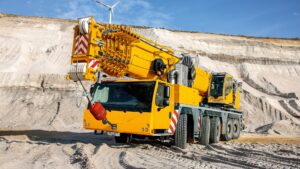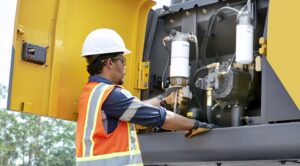Types and characteristics of HDS cranes
 The hydraulic loader crane is an advanced crane adapted to loading and unloading goods. Its compact design and mechanical drive mean that it can reach a place inaccessible to other cranes. There are general purpose HDSs; transhipment, which are mounted on the rear of the vehicle or semi-trailer, and those with a rigid structure mounted on the chassis.
The hydraulic loader crane is an advanced crane adapted to loading and unloading goods. Its compact design and mechanical drive mean that it can reach a place inaccessible to other cranes. There are general purpose HDSs; transhipment, which are mounted on the rear of the vehicle or semi-trailer, and those with a rigid structure mounted on the chassis.
Application of hydraulic cranes
HDS is widely used in reloading work in many situations, for example:
- on small construction sites where the use of heavy equipment is impossible;
- for loading, transporting and unloading construction materials, such as paving stones, bricks, hollow bricks, roof tiles, sheets, etc.;
- for transporting building materials to higher storeys;
- for the transport and unloading of containers;
- in forestry for the export of timber;
- for stacking containers.
How to choose a crane for the industry and the type of tasks to be performed?
As the cranes are mounted on various types of chassis and have different reach, design and lifting capacity, the specific type of HDS used in a given industry area prevails. Examples of the use of cranes in specific sectors:
- in the construction industry - medium and large cranes used to transport containers and bulky materials, classic L-type machines prevail;
- in roadside assistance - they are found more and more often, in most cases these are T-type cranes;
- in scrap yards - Z devices used for recycling works, which are equipped with a scrap gripper;
- in the municipal sector - mounted on hook lifts and garbage trucks, equipped with container openers;
- in energy works - electricians most often use truck cranes, currently mobile cranes in the range of 35-95 tons are mainly used.
Construction of an HDS crane
Lifts of this type are constructed of fixed and variable parts. The most important solid parts are:
- stabilizing supports - placed on each side to balance the weight of the crane;
- crane base - the crane is mounted on it, it does not change despite the enormous loads it is subjected to;
- crane column - the vertical part connecting the platform with the hoist, sometimes in a telescopic arrangement, which speeds up the work;
- boom - a moving part that carries loads.
Variable elements adapted to the type of work:
- hydraulic system - most new machines are already based on hydraulic cylinders, thanks to them the work is faster and more precise;
- grapple - useful especially when transporting loads with irregular shapes, e.g. wood;
- hook - the most frequently used variable part, used for transporting very heavy goods.
The slings, ropes and hooks used in HDS
In order to manipulate loads, various types of interchangeable elements are used, such as:
Ropes - needed when using a crane with a winch;
Slings - auxiliary equipment, which includes steel ropes, fiber ropes, chains or tapes;
Hooks - working accessories included in the loading crane.
Maintenance of a hydraulic truck crane
 Maintenance of the HDS should take place within the time limits specified in the device's operating manual. Regularly check the technical condition of the drive mechanisms, braking systems and load-bearing tendons with their fastenings. The load-bearing structure and fire protection systems should be checked once a year. It is important to check the controls, signaling devices, lighting and movement limiters. Regularity in carrying out inspections will allow you to avoid both faults and accidents.
Maintenance of the HDS should take place within the time limits specified in the device's operating manual. Regularly check the technical condition of the drive mechanisms, braking systems and load-bearing tendons with their fastenings. The load-bearing structure and fire protection systems should be checked once a year. It is important to check the controls, signaling devices, lighting and movement limiters. Regularity in carrying out inspections will allow you to avoid both faults and accidents.
The inspector of the Office of Technical Inspection performs supervision over the device maintenance log, the revision book and the qualifications of operators and maintenance technicians.
Entitlements
In order to operate hydraulic truck cranes, it is necessary to have the relevant qualifications, which can only be obtained after passing the relevant course and a state examination organised by the UDT.
A person who wants to qualify as an HDS operator must be at least 18 years of age, have a minimum basic education and no health contraindications to perform this type of work. In the case of foreigners, knowledge of the Polish language or certification of a sworn translator is expected. An additional advantage will be a category C driving license.
A positive result of the UDT exam results in obtaining a qualification certificate, which entitles to service portable and mobile cranes for 10 years.
If you want to work abroad, most employers accept the qualifications obtained in Poland, but the final decision on employment rests with the owner of the enterprise.
What does crane operator training look like?
The training of the operator of portable and mobile cranes includes:
- construction and equipment of cranes
- knowledge of security operation
- operation and knowledge of the operating instructions
- knowledge of the operator's duties before, during and after work on the device
- selection of variable parts depending on the work performed
- estimating the center of gravity of a load based on its weight and size
- knowledge of health and safety regulations
- providing first aid in the event of an accident
Operator responsibilities before, after and during operation
The person operating the hydraulic hoist should read the technical documentation of the crane (operator's manual, certificate of approval and maintenance book - the lack of one of these documents makes it impossible to start work).
You should remember to carry out a visual inspection, that is:
- tank tightness control,
- examining the operation of hydraulic locks, security and blockades,
- checking the protrusion of the supports.
Any irregularity must be reported to your supervisor.
During the work, the operator is responsible for:
- visual inspection of the area and determination of the crane's range
- preparation of the device
- checking the permissible load of HDS
- proper hooking of the load and its securing
- constant control of transported materials and the crane
- immediate response in the event of irregularities or failures
After completing work on the HDS crane, the operator should:
- assemble the equipment in such a way that it is ready for transport
- fold the supports and secure them
- check that the transported materials do not pose a threat
- put the equipment in the garage
- secure the device so that people without UDT authorization cannot use it
- submit the crane's documents to the supervisor or an authorized person
Activities prohibited in working with HDSs
To avoid accidents involving people or damage to the load and device, do not:
- use the crane without valid tests to be approved for use (by the UDT inspector)
- transport loads with unknown parameters
- carry the load without first making sure that it is not attached to the ground
- work without unfolded supports
- use the device in difficult weather conditions
- work near hazards, e.g. high voltage lines or on unstable ground
- move loads over people and their workstations

































